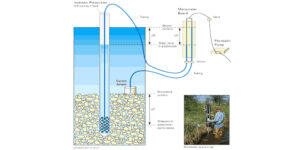Piezometers are the geotechnical sensors that are used to measure pore water pressure (piezometric level) in the ground. It is designed to measure pore water pressure in the soil, earth/rock fills, foundations, and concrete structures.
The piezometer or pore pressure meter provides significant quantitative data on the magnitude and distribution of pore pressure and its variations with time. It also helps in evaluating the pattern of seepage, zones of potential piping, and the effectiveness of seepage control measures undertaken.
Considered as one of the most important geotechnical monitoring instruments, it’s interesting to study as well. Let’s discuss more piezometer, their types, working principle, applications, and function in detail.

What Is A Piezometer?
A piezometer is either a device used to measure liquid pressure in a system by measuring the height to which a column of the liquid rises against gravity or a device that measures the pressure (more precisely, the piezometric head) of groundwater at a specific point. A piezometer is designed to measure static pressures and thus differs from a pitot tube by not being pointed into the fluid flow.
Observation wells give some information on the water level in a formation, but must be read manually. Electrical pressure transducers of several types can be read automatically, making data acquisition more convenient.
The first piezometers in geotechnical engineering were open wells or standpipes (sometimes called Casagrande piezometers) installed into an aquifer. A Casagrande piezometer will typically have a solid casing down to the depth of interest, and a slotted or screened casing within the zone where water pressure is being measured.
The casing is sealed into the drill hole with clay, bentonite, or concrete to prevent surface water from contaminating the groundwater supply. In an unconfined aquifer, the water level in the piezometer would not be exactly coincident with the water table, especially when the vertical component of flow velocity is significant.
In a confined aquifer under artesian conditions, the water level in the piezometer indicates the pressure in the aquifer, but not necessarily the water table. Piezometer wells can be much smaller in diameter than production wells, and a 5 cm diameter standpipe is common.
Piezometers in durable casings can be buried or pushed into the ground to measure the groundwater pressure at the point of installation. The pressure gauges (transducer) can be vibrating-wire, pneumatic, or strain-gauge in operation, converting pressure into an electrical signal.
These piezometers are cabled to the surface where they can be read by data loggers or portable readout units, allowing faster or more frequent reading than is possible with open standpipe piezometers.
Why Is A Piezometer Used?
The use of a piezometer has the following purposes:
- To study the effect of water in pores of soil or rock is to reduce load bearing capacity of soil or rock. Effect is more pronounced with higher pore water pressure leading eventually in some cases to total failure of load bearing capacity of the soil.
- To determine level and flow pattern of groundwater
- To determine the flow pattern of water in earth/rockfill, concrete dams, and their foundations.
- To delineate the phreatic line.
Types Of Piezometers
- Standpipe Piezometers
- Vibrating Wire Piezometers
- Pneumatic Piezometers
- Titanium Piezometer
Piezometer Applications
Piezometers measure pore-water pressure and groundwater levels, providing information essential to:
- Understanding initial site conditions.
- Determining safe rates for placement of fill
- Predicting slope stability.
- Designing for lateral earth pressures.
- Evaluating the effectiveness of drainage schemes.
- Checking the performance of containment systems.
